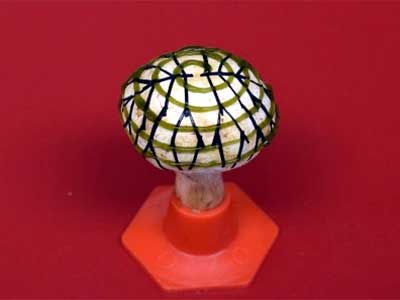Many examples of organisms that live closely together and interact with each other exist in nature. In some cases, this symbiotic relationship is mutually beneficial.
A team of researchers led by Manu Mannoor and Sudeep Joshi from Stevens Institute of Technology wanted to engineer an artificial symbiosis between button mushrooms and cyanobacteria.
To make their bionic mushroom a reality, the researchers first 3D printed an electronic ink containing graphene nanoribbons onto the cap of a living mushroom in a branched pattern. They then printed a bio-ink containing cyanobacteria onto the cap in a spiral pattern, which intersected with the electronic ink at multiple points.
Shining a light on the mushroom activated cyanobacterial photosynthesis, generating a current of about 65 nanoamperes. Although this current is insufficient to power an electronic device, the researchers say that an array of bionic mushrooms could generate enough current to light up an LED.
















